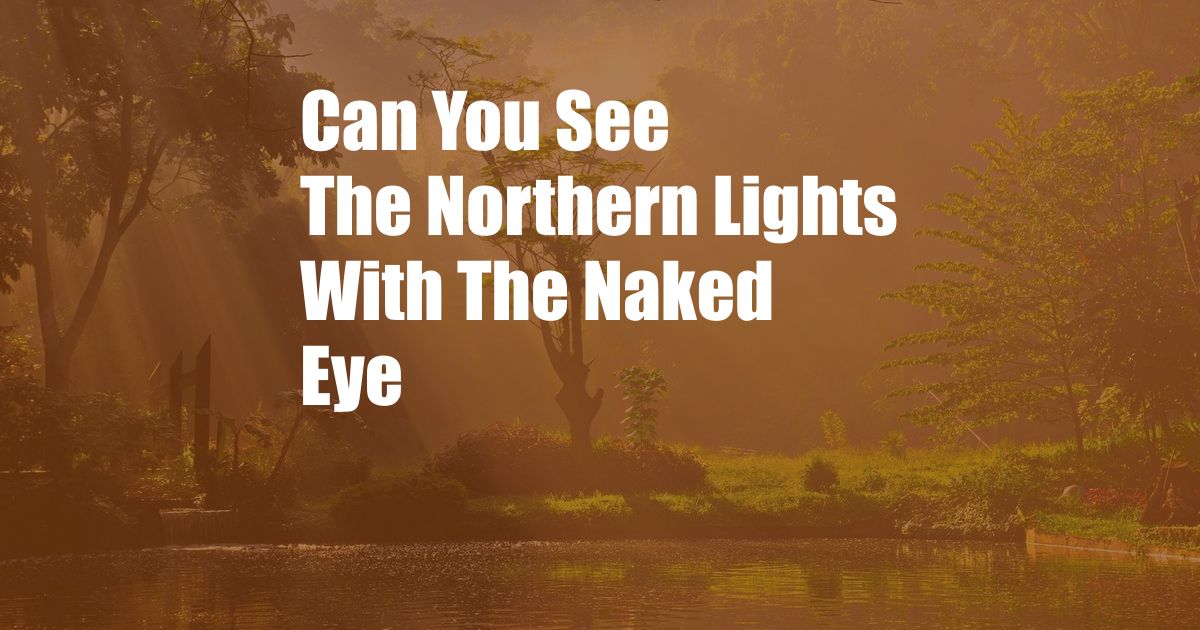
Can You See the Northern Lights with the Naked Eye?
I was fortunate enough to witness the Aurora Borealis, also known as the Northern Lights, during a recent trip to Alaska. The vibrant hues of greens and reds swirled and danced across the sky, illuminating the vast wilderness below. It was a surreal experience that left me in awe of nature’s beauty.
While the Northern Lights are often depicted as a captivating celestial spectacle, I couldn’t help but wonder if it was truly possible to see them with the naked eye. After all, the faint shimmer of stars often requires the use of binoculars or telescopes to be fully appreciated. To unravel the answer, I embarked on a quest for knowledge, exploring the scientific principles behind the Northern Lights and the factors that influence their visibility.
Deciphering the Elusive Aurora
The Northern Lights are a consequence of the interaction between charged particles from the sun and the Earth’s magnetic field. These particles, primarily protons and electrons, are emitted from the sun’s atmosphere and travel through space, reaching the Earth’s vicinity. When these particles encounter the Earth’s magnetic field, they are deflected towards the magnetic poles, where they interact with atoms and molecules in the atmosphere.
This interaction excites the atoms and molecules, causing them to emit light. The color of the emitted light depends on the type of atom or molecule that is excited. Oxygen atoms, for instance, produce green and red light, while nitrogen atoms emit blue and purple hues. The intensity of the Northern Lights varies based on the number of charged particles striking the atmosphere and the strength of the magnetic field.
Factors Influencing Visibility
While the Northern Lights are a natural phenomenon, their visibility can be affected by several factors. One crucial element is the level of darkness. The darker the night sky, the more prominent the Northern Lights will appear. Urban areas with light pollution can significantly hinder the visibility of the aurora.
Another critical factor is cloud cover. Clouds can obstruct the view of the Northern Lights, as they block the light emitted from the atmosphere. For optimal viewing, it’s essential to seek out clear skies with minimal cloud cover.
Additionally, the strength of the Northern Lights themselves plays a role in their visibility. More intense auroras are more easily visible, even under less ideal conditions. The intensity of the Northern Lights is influenced by the solar activity, which follows an approximately 11-year cycle. During periods of high solar activity, the Northern Lights are more likely to be visible.
Tips for Enhanced Viewing
If you’re planning to witness the Northern Lights, here are a few tips to enhance your chances:
1. Choose a Dark Location: Venture away from urban areas and light pollution to a remote location with minimal artificial light.
2. Monitor Solar Activity: Keep an eye on solar activity forecasts to identify periods of high aurora activity.
3. Check the Weather: Consult weather forecasts to ensure clear skies with minimal cloud cover.
4. Allow Time for Adaptation: Give your eyes about 30 minutes to adjust to the darkness. Avoid using bright lights, as this can reduce your night vision.
Common Questions
Q: How far north do you need to go to see the Northern Lights?
A: The Northern Lights are typically visible in areas above 60 degrees north latitude, such as Alaska, northern Canada, and parts of Scandinavia.
Q: What time of year are the Northern Lights visible?
A: The Northern Lights can be seen during the winter months, from September to April, when the nights are longer and darker.
Q: Can you see the Northern Lights in the summer?
A: While it’s less common, the Northern Lights can sometimes be visible during the summer months in the far northern regions, such as northern Alaska and northern Norway.
Call to Action
Witnessing the Northern Lights is a truly awe-inspiring experience that should be on every adventurer’s bucket list. If you’re intrigued by this celestial phenomenon, consider planning a trip to a high-latitude destination during the winter months. Remember to follow the tips outlined in this article to maximize your chances of seeing the Northern Lights with your own eyes. Let the vibrant colors and ethereal beauty of the aurora captivate you, creating an unforgettable memory that will last a lifetime.
Are you fascinated by the Northern Lights? Share your thoughts and experiences in the comments below.